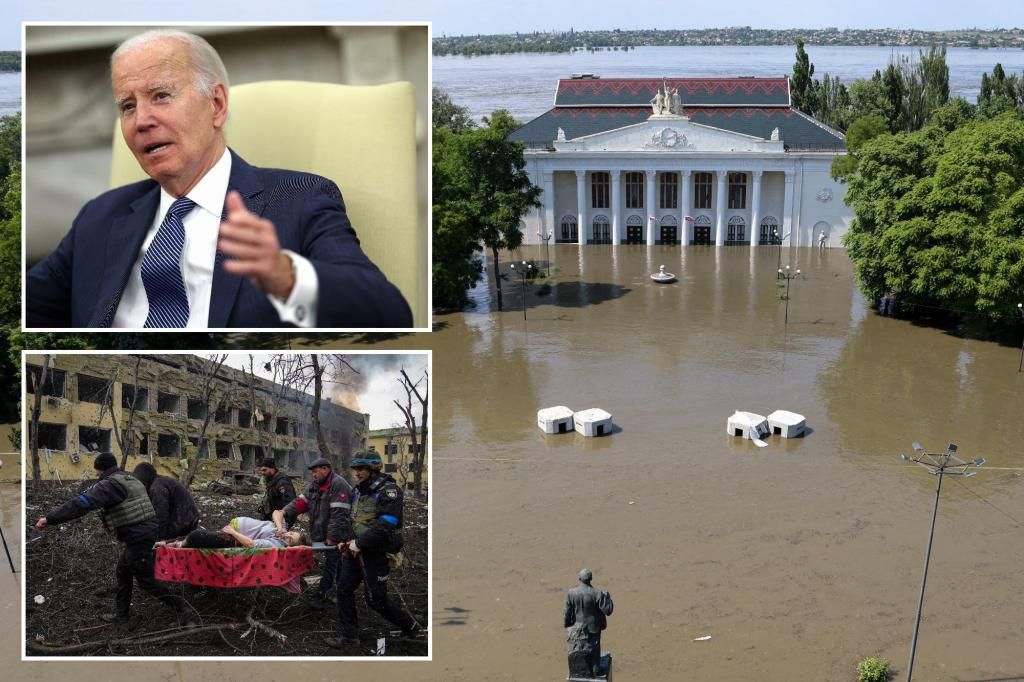It's time for Biden diplomacy
The escalation is here. What happens now?
Having recently returned from Ukraine, where I saw unmistakable evidence of Russian attacks on civilian targets, there is one thing of which I am confident: This isn’t going to end with the dam.
An explosion at the Nova Kakhovka dam in Ukraine has flooded downstream towns and villages, creating a humanitarian and ecological disaster. To get a sense of the bizarre character of this brutal conflict, consider that the animals at the nearby zoo were drowned and could not be rescued because the Russians, who are committed to a cartoon-villain model of warfare, had placed landmines around the facility.
The Ukrainian government says the dam was destroyed by the Russian forces who have controlled it since the first days of the invasion; the Russians blame Ukrainian saboteurs.
The destruction of the dam is in character for Ukraine’s Russian occupiers, who’ve carried out hundreds of attacks on Ukraine’s electrical grid and other similar targets. When they aren’t going after power and water, the Russians are targeting civilian medical care: In addition to the infamous airstrike on a maternity hospital in Mariupol in March 2022, Russian forces have relentlessly pounded other health-care facilities, according to WHO. Want more? In Bucha, the Russians massacred civilians, including health-care workers, and then trained sniper fire on those attempting to bury the dead.
A scene from the Russian attack on the Mariupol maternity hospital in 2022; Russia has made civilians a favorite target of their bombs — with no relief in sight. AP
A satellite image of the destroyed dam at Nova Kakhovka. The resulting flooding now imperils tens of thousands of Ukrainians and is proof-positive that the war’s long-awaited ‘escalation’ is happening. via REUTERS
The Ukrainians have warned for months that the Russians intend to create a crisis at the nuclear power plant at Zaporizhzhia, which relies on cooling water from a nearby reservoir quickly draining after the destruction of the Nova Kakhovka dam.
The Biden administration says it is worried about “escalation” in the Russian war on Ukraine. In reality, escalation is upon us—the question is: What does Biden intend to do about it?
Although Biden has provided Ukraine with a vast cache of military supplies, they often arrive after repeated requests and initial refusals. Getty Images
F-16 fighter jets, another piece of necessary defense weaponry that Biden initially said Ukraine would not be granted, only to switch course later on. But the exact date for Kyiv to receive the jets remains unclear. Getty Images
The Biden Administration first said that Ukraine would not be eligible to receive Patriot anti-missile missiles — but the White House then changed its mind. Getty Images
President Biden has shown that he is committed to doing the right thing in Ukraine . . . after he has exhausted every other option. His approach to Ukraine has been characterized by slow-walking practically all requests for aid and matériel, saying “No” to F-16s, “No” to the Patriot missile-defense system and other advanced equipment, only to reverse course, months later. So, now, the administration says Ukraine will receive those F-16 fighter jets — someday.
Air Force Secretary Frank Kendall says “Ukraine is going to remain an independent nation, it’s going to need a full suite of military capabilities, so it’s time to start thinking longer term.” And that is fine, except for the fact that if the Ukrainians do not prevail over Vladimir Putin’s effort to destroy their country, then Ukraine simply does not have a “longer term.”
President Volodymyr Zelensky wasn’t kidding when he told Western allies: “I need ammunition, not a ride,” following an evacuation offer during the war’s earliest days. Ukraine may have justice on its side, but the economics is another matter: With Patriot missiles costing about $4 million each, stopping those every-other-night air attacks on Kyiv is expensive, to say nothing of the rest of the war’s price tag. Russia’s annual GDP is around $2 trillion, more than ten times the size of Ukraine’s war-ravaged economy. And there is no Walmart for munitions: Converting funds into weapons is a complicated business, and Ukraine’s government, already dysfunctional before the war even started, is ill-equipped to stand on its own.
Scenes from Operation “Desert Storm” in 1991, which kicked Iraqi forces out of Kuwait in a mere matter of months. Getty Images
The US foreign-policy establishment is uncharacteristically timid at the moment, and the Ukraine debate is happening in the shadow of Iraq. But it is worth remembering that there were two Iraq wars, and the first one — driving Saddam Hussein’s forces out of Kuwait — was accomplished in a matter of weeks at a very low price measured in dollars or blood.
We are not talking about an open-ended nation-building program in a post-Putin Russia—we aren’t even talking about a military engagement on the level of Operation Desert Storm, which liberated Kuwait from Saddam Hussein back in 1991. What we should be talking about is a firm and public commitment to getting the Ukrainians what they need to repel the Russians —today, rather than at some point in a hypothetical long term.
Air Force Secretary Frank Kendall recently made clear that “Ukraine is going to remain an independent nation,” and for this to happen “it’s going to need a full suite of military capabilities.” REUTERS
“America is back!” President Biden boasted more than two years ago, promising a new era of energetic U.S. leadership in world affairs and engagement with our European allies. Right now, our European allies are in the midst of the continent’s most significant war of aggression and expansion since the 1940s. Joe Biden likes to think of himself as the new FDR — in truth, he doesn’t even have to be the new George H.W. Bush.
But nap time is over. What the Biden administration is engaged in is not diplomacy — it is dithering.
Kevin D. Williamson is the national correspondent for The Dispatch.
Source: New York Post


